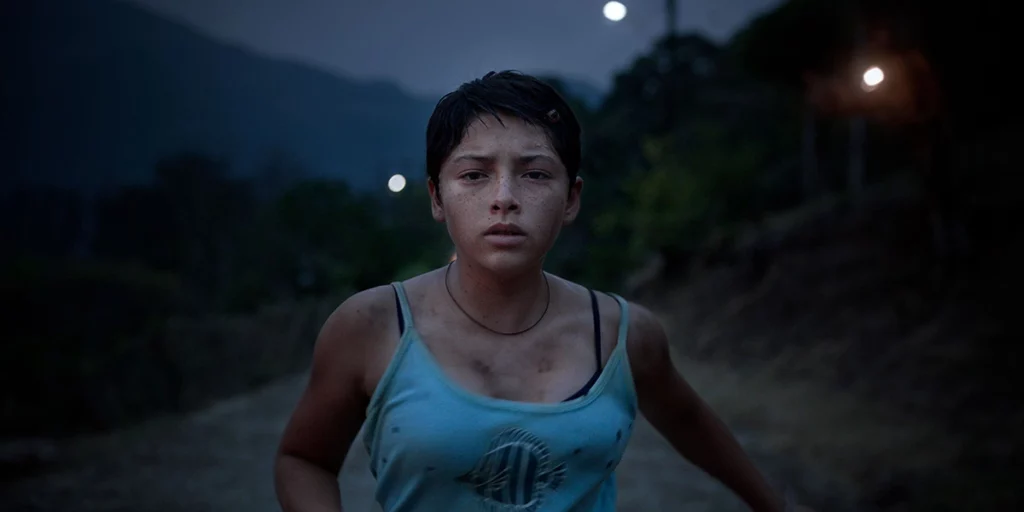Adolescence arrives amidst the backdrop of drug violence and human trafficking in Prayers for the Stolen, a disturbing and gritty drama.
The opening of Prayers for the Stolen is stark in its bleakness: a young girl digs a hole – not her grave, but it could just as well be – with her mother before lying down in it silently. The tone is set instantly, the slow creeping of evil and violence seeping onto the screen more and more with each passing minute. Tatiana Huezo expertly crafts a world that is harrowing and truthful in its depiction of the drug trade and human trafficking, and the effects these things have on local communities. Prayers for the Stolen never adds unnecessary action or glorified violence nor does it frame these ongoing real-world events in thriller format; instead, it opts for grounded, refined depictions of the trauma this ongoing war is causing.
Based on Jennifer Clement’s novel of the same name, Prayers for the Stolen focusses not on the army or cartel soldiers involved in this war – they are faceless, nameless entities with guns – but on the people at the very bottom of the chain, in particular the residents of a small rural village in the Mexican state of Guerrero. These victims are largely helpless but completely humanised. Three girls – Ana, Paula and María – form the basis of the narrative, with their formidable friendship bringing real personality to the film as well as moments of light humour and extreme emotional resonance. Prayers for the Stolen gives ample time to each of these girls first as children and then as teenagers, with Huezo expertly shaping their experiences and changing personalities.
In an ideal world, the girls’ lives in the village would be the same as any normal coming-of-age film, their worries not reaching to anything more serious than homework deadlines or who they fancy that week. But the ravaging effect of the drug trade bleeds through the village and inevitably affects every single resident. Huezo’s script for Prayers for the Stolen signals that even the most normal tasks and life events carry extra danger and meaning: the girls getting a haircut isn’t to avoid lice but abduction; a first period carries a very different significance to what should be a normal, becoming-a-woman moment; villagers struggling to get phone signal isn’t just an annoyance but an absolute necessity in order to get financial help from relatives living elsewhere.
Everything in Prayers for the Stolen is soaked with this heavy dread and ulterior meaning, but even though these worries remain largely unspoken, they are absolutely not invisible. Huezo makes this clear early on in the film, with a young girl the same age as Ana, Paula and Mariá stolen by the cartel.

Dariela Ludlow’s cinematography enforces this entrapment and helplessness. As Ana lies in a hiding place – the hole she was digging at the start – Ludlow shoots from the teenager’s viewpoint, capturing the free flight of birds in the blue sky obscured by the cover of the hole. Miguel Schverdfinger’s considered editing bolsters these shots even further; a quick switch from a teacher talking about cartel members asking for payments to an intense close-up of ants on the ground signifies the crawling corruption descending upon the village. Normal conversations between children are followed up by children of the same age holding guns, with every filmmaking choice in Prayers for the Stolen working to respectfully depict this harsh world.
But not all of Prayers for the Stolen is a morose procession of suffering. There are moments of levity, such as when María has surgery to stitch together her cleft lip and sees her new smile for the first time. The three friends’ relationship is key too. In a wider sense Prayers for the Stolen is about the drug trade in Mexico, but it frames it within the parameters of a strong female friendship. Six actors play Ana, Paula and María – three as children, three as teenagers – and all imbue the characters with a childlike normality and charm, whilst still capturing their fear at the violent world surrounding them. As Ana’s mother Rita, Mayra Batalla delivers a powerful performance as a single parent trying to do the best for her child. When she acts out and snaps at Ana, it’s out of frustration and anger for the situation, not due to anything Ana has done. Prayers for the Stolen is an expert balance between full-blooded danger and lighter moments of childhood friendship.
All the children – Ana in particular – see so much suffering and pain throughout Prayers for the Stolen that it’s a wonder they are still walking by the end. Their minds and emotions are battered, but their determination to keep going is so fierce that it will silently but surely get under your skin. The three friends use games to calm themselves in the hardest moments and pick a small rock each to bind themselves together. Huezo allows the most violent or harrowing moments to take place offscreen, their occurrence only alluded to through dialogue or subtle shots of the aftermath, amplifying the sense of lurking but almost hidden danger in this world. Even amidst these perils, Prayers for the Stolen remains a touching account of female friendship and the bravery of the human spirit.
Prayers for the Stolen had its Scottish Premiere at the 2022 Glasgow Film Festival on 10 March, 2022, and is now available to watch on Netflix.

